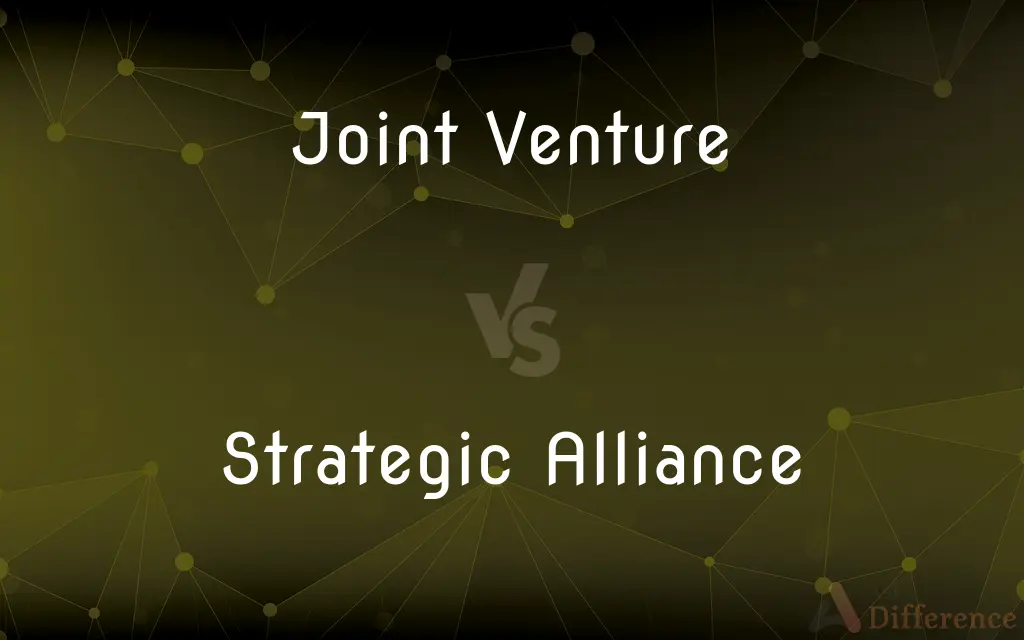Joint Venture vs. Strategic Alliance — What's the Difference?
Edited by Tayyaba Rehman — By Fiza Rafique — Published on January 12, 2024
A Joint Venture is a formalized partnership where two or more entities create a new entity, sharing resources and profits, while a Strategic Alliance is a collaborative agreement between firms without forming a new entity.

Difference Between Joint Venture and Strategic Alliance
Table of Contents
ADVERTISEMENT
Key Differences
A Joint Venture typically refers to two or more companies coming together to form a new business entity. This collaboration aims to achieve specific objectives and share both profits and losses. On the other hand, a Strategic Alliance does not involve the creation of a new entity. Instead, it's an agreement between companies to work towards common goals.
In a Joint Venture, the involved parties often pool their resources, including capital, technology, and expertise. This sharing is to leverage the strengths of each party for mutual benefits. In contrast, a Strategic Alliance allows each company to maintain its independence. Here, firms collaborate on particular projects or initiatives while leveraging their own resources.
The binding nature of a Joint Venture often means a longer-term commitment and involves shared ownership, operational control, and governance. Whereas, a Strategic Alliance is generally more flexible. Companies in a Strategic Alliance can quickly adapt or even exit the alliance based on changing circumstances.
When businesses opt for a Joint Venture, they are looking for a deeper integration and synergy in operations, sales, or technologies. However, when they go for a Strategic Alliance, they are mainly aiming for cooperation in specific areas without a broader merger of company cultures or assets.
Joint Ventures usually demand more significant investments and commitments from the involved parties. This is because they're sharing in the risks and rewards of the new entity. A Strategic Alliance, in contrast, allows firms to collaborate at a less intensive level, usually with fewer binding obligations.
ADVERTISEMENT
Comparison Chart
Nature
Formation of a new business entity.
Collaborative agreement without forming a new entity.
Commitment Level
Often longer-term with shared ownership and governance.
Generally more flexible and can be short-term.
Resource Sharing
Pooling of resources like capital, technology, and expertise.
Collaboration using own resources, without full integration.
Binding Intensity
High due to shared risks and rewards.
Lower with fewer binding obligations.
Objective
Deeper integration in operations, sales, or technologies.
Cooperation in specific areas without broader merger.
Compare with Definitions
Joint Venture
A business arrangement where two or more parties establish a new entity.
Company A and Company B formed a Joint Venture to tap into a new market.
Strategic Alliance
A collaboration between firms to leverage synergies without forming a new company.
Their Strategic Alliance enabled them to co-market their products effectively.
Joint Venture
A mutual agreement to co-operate on a particular project or market.
The construction firms entered a Joint Venture to bid on the large infrastructure project.
Strategic Alliance
An agreement between companies to pursue shared objectives while remaining independent entities.
The two tech giants entered a Strategic Alliance to innovate in artificial intelligence.
Joint Venture
A partnership often involving shared investments, resources, and governance.
Their Joint Venture allowed both companies to share the costs of research and development.
Strategic Alliance
A business relationship allowing parties to cooperate in specific areas.
The companies formed a Strategic Alliance to combine their distribution networks.
Joint Venture
A union of organizations to exploit an opportunity while distributing risks.
The Joint Venture aimed to combine their strengths in the competitive industry.
Strategic Alliance
A partnership emphasizing mutual benefits without a merger or shared ownership.
The Strategic Alliance focused on joint research efforts in sustainable energy.
Joint Venture
A collaborative effort between firms to achieve a specific goal, sharing profits and losses.
The Joint Venture between the tech firms resulted in a revolutionary new product.
Strategic Alliance
A formal agreement to share resources, knowledge, or capabilities for mutual gain.
Through their Strategic Alliance, the firms accessed new technologies from each other.
Common Curiosities
How is a Joint Venture different from a Strategic Alliance?
While a Joint Venture involves forming a new entity, a Strategic Alliance is a collaborative agreement without creating a new company.
What's a Joint Venture?
A Joint Venture is a business partnership where two or more parties create a new entity, sharing resources, profits, and losses.
Can companies exit a Strategic Alliance easily?
Generally, Strategic Alliances offer more flexibility, but exit terms depend on the specifics of the alliance agreement.
Can a Joint Venture involve more than two companies?
Yes, a Joint Venture can involve multiple companies coming together for a shared purpose.
Why might companies opt for a Joint Venture?
Companies may pursue a Joint Venture for deeper integration, shared investments, risk distribution, or to enter new markets jointly.
Who controls the operations in a Joint Venture?
Control in a Joint Venture is typically shared, but the degree of control for each party is determined by the agreement.
Can a Joint Venture be short-term?
While Joint Ventures can be for a limited duration, they often involve longer-term commitments due to shared investments and objectives.
What are the benefits of a Strategic Alliance?
A Strategic Alliance allows companies to collaborate, share resources, and expertise without the need for deeper integration or forming a new entity.
Is a Strategic Alliance legally binding?
A Strategic Alliance often involves formal agreements, but the binding nature can vary based on the terms and objectives set by the parties.
Do Strategic Alliances always involve shared revenues?
No, while some Strategic Alliances might involve revenue-sharing, others focus on collaboration without direct financial exchanges.
Is equity always involved in a Joint Venture?
While many Joint Ventures involve equity participati
How are profits and losses managed in a Joint Venture?
Profits and losses in a Joint Venture are typically shared based on the terms set in the joint venture agreement.
Is a merger the same as a Joint Venture?
No, a merger is the full integration of two companies into one, while a Joint Venture retains the individual identities of the partnering companies.
What's a common reason for a Strategic Alliance?
Companies often form Strategic Alliances to leverage each other's strengths, access new markets, or collaborate on innovation without merging.
Can a Strategic Alliance lead to a Joint Venture?
Yes, sometimes companies start with a Strategic Alliance and, seeing its success, decide to form a Joint Venture for deeper collaboration.
Share Your Discovery

Previous Comparison
Open Loop Control System vs. Closed Loop Control System
Next Comparison
Delegates in C# vs. Events in C#Author Spotlight
Written by
Fiza RafiqueFiza Rafique is a skilled content writer at AskDifference.com, where she meticulously refines and enhances written pieces. Drawing from her vast editorial expertise, Fiza ensures clarity, accuracy, and precision in every article. Passionate about language, she continually seeks to elevate the quality of content for readers worldwide.
Edited by
Tayyaba RehmanTayyaba Rehman is a distinguished writer, currently serving as a primary contributor to askdifference.com. As a researcher in semantics and etymology, Tayyaba's passion for the complexity of languages and their distinctions has found a perfect home on the platform. Tayyaba delves into the intricacies of language, distinguishing between commonly confused words and phrases, thereby providing clarity for readers worldwide.
















































